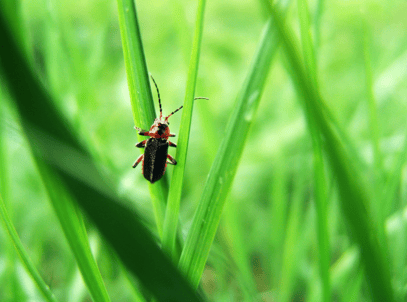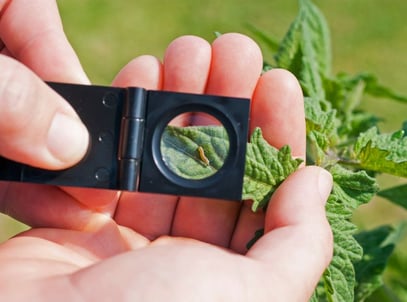
Home / Here on Earth / The Natural Choice: Integrated Pest Management
As some industries begin adjusting and considering sustainable practices, many still lag behind.
The lawn and landscape industry may have a fascinating array of technology and innovations available, but only so many providers end up adapting them. One such innovation, known as Integrated Pest Management (IPM), is widely accepted as the standard in agriculture, forestry, and horticulture, but not so much in landscape and lawn care. While many landscape companies offer a choice between IPM and Traditional Pest Management (TPM), some landscape providers have completely switched over to IPM.
We're here to check out the buzz around IPM, figure out if it's worth the hype, and help you decide on a safe, sustainable pest control plan.
Why Mess With Tradition?

TPM centers around pesticide applications, typically with a professional performing an application of pesticides, either once or routinely. Traps or bait may be set, and these similarly contain pesticides and poisons. The main goal of TPM is to eliminate pests immediately. This way, the customer sees their desired results and the professional only makes one trip.
Unfortunately, even with the most precise applications, 95-98% of pesticides end up somewhere other than their intended application, with wind and rain carrying chemicals miles away. Pesticides can easily disrupt an ecosystem and introduce hormone-altering chemicals.
Lake Apopka in Central Florida was victim to years of pesticide and fertilizer runoff from the 1950s to 1980s, which eventually led to dead birds, deformed alligators, and even illnesses in exposed Apopka farmworkers. Thankfully, the pesticide responsible for that damage was banned in 1972, but modern-day pesticides can still have unseen effects.
The bottom line regarding pesticides is that they are chemicals made to damage and kill plants, and they can have harmful effects on other plants, wildlife, pets, and people. When implementing IPM, this is a program where there are alternative methods of pesticides that can be evaluated. If the chemical application is decided upon, the chemical chosen is a minimal risk pesticide that shows little to no harm to the environment and humans.
Steps Of Integrated Pest Management
It is essential to follow five steps for an effective IPM program.
1. Pest Identification
Correct identification of the pest is necessary because various pests may not be controlled by a single method. Use pest identification guides or call your local county extension office to help identify a serious pest.
Observe the type of plant it was found feeding on and the damage caused as well. For instance, chewing pests, such as caterpillars or beetles, will bodily remove leaf material. Yellow or brown speckling on leaf surfaces may show a sign of piercing-sucking damage from pests like lace bugs, aphids, or spider mites.
Secondary symptoms, such as sooty mold on leaves’ top surface, may indicate that whiteflies, aphids, or soft scales have been obtaining their nourishment on the leaves above. After the pest is identified, understand its life cycle, the time it is most active, and when it is most susceptible to control methods. Determining the general biology of the pest is important to the next stages of the IPM framework.
2. Monitoring

After the pest has been identified, landscape managers must check the pest's activity and keep track of its location in the landscape. Monitoring is the frequent inspection of plants to find the existence of damaging pests, make observations, and keep a check on the movement of those pests. Monitoring reveals to the manager what is happening in the ecosystem of the landscape. Preceding control measures can also be assessed by monitoring pest populations after the treatment.
The most popular monitoring method is visually examining plant material. Look below the leaves with a hand lens to check insects feeding or indications of feeding. If leaves have been fed on, check leaves underneath for insect excrement to know if it is a caterpillar.
Hitting plant material onto a white surface can also displace insects for simpler counting and identification. Different trapping devices can attract insects for monitoring purposes. Monitoring allows managers to identify pest-prone areas and look out for pest activity throughout the year.
Recording humidity, rainfall, and temperature may help to foretell pest activity as insects are instantly affected by their environment. Degree-day models help forecast pest growth and activity depending on how many days the pests are exposed to temperatures sufficiently warm for them to develop. Degree-day models have been developed for several landscape pests and can be acquired from local UF/IFAS Extension offices.
3. Decision Making
At what degree of damage or infestation is it time to interfere? One of the most troublesome stages in the IPM framework is to decide when control measures are to be implemented. If a pest has grown in population, you must take a decision about the degree of tolerable damage to the plants. Any level of damage in ornamental landscapes is usually intolerable. However, this entirely depends on the type of pest, the function of the landscape, the plant involved, and the cost of control measures. Aesthetic thresholds and damage can assist with these decisions. Thresholds exist for some landscape pests, however, are still required for many others.It is important to consider the timing of control measures because their effectiveness can be strongly based on the life stage of the pest. For instance, immature scale insects in their crawler stage are much more vulnerable to insecticide applications compared to adults. Also, if the insects are soon going to be adults, they may fly away or stop feeding after treatment, leading to unnecessary or ineffective treatment.
4. Intervention
IPM is a major component of Plant Health Care (PHC). PHC is considered the most holistic and sustainable way to install and maintain healthy greenery. IPM differentiates from TPM by considering the health of the plants, the surrounding ecosystem, and even human culture to naturally reduce and prevent pests.
Cultural- Despite our natural reaction, creatures we consider pests remain an integral and vital component of our daily lives. The food we eat, the products we use, and even the clothes we wear all derive from or depend on what some people consider pests. Changing the way we think about bugs, rodents, and other pests can help us accept the ones that we need to coexist with and better identify those that can actually harm us.
Biological- Using a biological approach, you can determine a pest's likes and dislikes, food sources, and natural predators. Once you or a professional know your pests' biology and environment, you’ll use this knowledge to make your space less hospitable to your problem pests. The typical residential community is rife with food, water, and shelter sources for common pests. Once you remove them from your yard, the pests move on. Professionals can even introduce predator species, parasites, or pathogens to target a pest using its natural enemies.
Physical- The physical landscape and the way that it is cared for have a big effect on why pests are attracted or repelled. Many pests are attracted to weeds or rotting vegetation, so If you or your lawn care provider leave out grass clippings, pulled weeds, and exposed roots, a critter is bound to come to check it out. Even installing native plants and planting within season can affect what lives in them.
Chemical- All other options should be exhausted before considering a chemical approach, and only in the direst of circumstances. The EPA has identified a list of “Minimum Risk Pesticides” that may be utilized in small controlled amounts without causing detrimental effects. Even if chemicals are utilized, it's crucial to keep in mind the other cultural, biological, and physical factors we’ve discussed.
5. Evaluation
The final stage in an IPM program is to assess the management strategies that were taken by evaluating their efficacy, cost, and overall value. This will help to find areas that performed well or require improvement. An effective IPM program is consistently developing to address old and new demands of landscape pest management.
What You Can Do?
Whether you’re deciding on a landscape company or deciding how to tackle your own backyard, make sure to consider the amount of time and effort you’re willing to put in over time. While the traditional approach may seem cheaper at first, you’ll need to keep spraying and keep paying every time the pests return.
There’s no shame in asking a lawn care professional for help. Experts trained in IPM can identify, monitor, and control your pests for you and give you time to enjoy life, pest free with minimal chemical use.
Down To Earth Landscape & Irrigation considers Integrated Pest Management the only option for companies looking to sustainably provide the best results.
